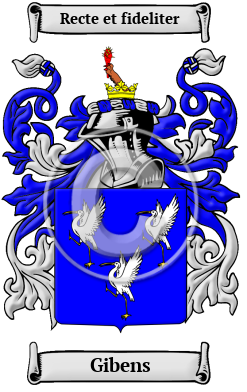| ![Show Contents]() Gibens History, Family Crest & Coats of Arms Gibens History, Family Crest & Coats of Arms
Etymology of GibensWhat does the name Gibens mean? The Gibens family history stretches back to the clans of the Dalriadan kingdom on the sea-swept Hebrides islands and mountainous western coast of Scotland. The name Gibens is derived from the given name Gibb, which is a diminutive form of the name Gilbert. 1 Early Origins of the Gibens familyThe surname Gibens was first found in Galloway (Gaelic: Gall-ghaidhealaibh), an area of southwestern Scotland, now part of the Council Area of Dumfries and Galloway, that formerly consisted of the counties of Wigtown (West Galloway) and Kirkcudbright (East Galloway), where they held a family seat from very early times. Descended from a chieftain, Gilbert, probably Gilbert, Lord of Galloway, the Gibsons settled first at Lennox in Scotland, and in those early times was a formidable force to be encountered. The first official mention was when John Gibson surrendered the Castle of Rothesay in 1335. A few years later, Thomas Gibbeson was charged with breaking parole in 1358; and John Gybbessone was listed as a servitor of William Douglas when he was held hostage by Henry Vi in 1425.1 Later a branch of the family were well established in the sea-port and ancient burgh of barony of Levin in Fifeshire. "This place, which is agreeably situated on the sea-shore at the mouth of the river whence it takes its name, was erected into a burgh of barony by charter of the proprietor of the lands of Durie, now belonging to the Christies, but once in the possession of the family of Gibson, whose descendants, the lords Durie, are distinguished in Scottish history." 2 Early History of the Gibens familyThis web page shows only a small excerpt of our Gibens research. Another 153 words (11 lines of text) covering the years 1488, 1513, 1540, 1562, 1590, 1600, 1603, 1615, 1637, 1644, 1656, 1668, 1669, 1690, 1693, 1696, 1698, 1701, 1702, 1717, 1748 and 1890 are included under the topic Early Gibens History in all our PDF Extended History products and printed products wherever possible. Gibens Spelling VariationsSpelling in the medieval era was a highly imprecise process. Translation, particularly from Gaelic to English, was little better. For these reasons, early Scottish names are rife with spelling variations. In various documents Gibens has been spelled Gibson, Gibsone, Gibsons, Gipson, Gibsoun, Gipsone, Gibbson, Gibbsone, Gippson and many more. Early Notables of the Gibens familyRichard Gibson (1615-1690), known as "Dwarf Gibson", a painter of portrait miniatures and a court dwarf in England during the reigns of Charles I, Oliver Cromwell, Charles II and William and Mary; Sir John Gibson, of Alderstone, in Ratho parish, near Edinburgh; and his son, Sir John Gibson (ca. 1637-1717), founder of the Gloucestershire Regiment and Member of Parliament for Portsmouth, 1696-1698 and 1702.
Thomas Gibson (d. 1562), was an English printer, medical practitioner, and theological writer and a native of Morpeth, Northumberland.
Sir Alexander Gibson , Lord Durie (d. 1644), was a Scottish judge and son of George Gibson of Goldingstones, a...
Another 151 words (11 lines of text) are included under the topic Early Gibens Notables in all our PDF Extended History products and printed products wherever possible. Migration of the Gibens family to IrelandSome of the Gibens family moved to Ireland, but this topic is not covered in this excerpt.
Another 59 words (4 lines of text) about their life in Ireland is included in all our PDF Extended History products and printed products wherever possible.
| Gibens migration to the United States | + |
Settlers from Scotland put down roots in communities all along the east coast of North America. Some moved north from the American colonies to Canada as United Empire Loyalists during the American War of Independence. As Clan societies and highland games started in North America in the 20th century many Scots rediscovered parts of their heritage. Early North American records indicate many people bearing the name Gibens were among those contributors:
Gibens Settlers in United States in the 20th Century- Amos J Gibens, aged 45, who landed in America, in 1911
- Mary Gibens, aged 30, who immigrated to America, in 1911
| Contemporary Notables of the name Gibens (post 1700) | + |
- François "Frans" Gibens (1896-1964), Belgian silver medalist gymnast at the 1920 Summer Olympics
The motto was originally a war cry or slogan. Mottoes first began to be shown with arms in the 14th and 15th centuries, but were not in general use until the 17th century. Thus the oldest coats of arms generally do not include a motto. Mottoes seldom form part of the grant of arms: Under most heraldic authorities, a motto is an optional component of the coat of arms, and can be added to or changed at will; many families have chosen not to display a motto.
Motto: Recte et fideliter
Motto Translation: Just and faithful.
- Black, George F., The Surnames of Scotland Their Origin, Meaning and History. New York: New York Public Library, 1946. Print. (ISBN 0-87104-172-3)
- Lewis, Samuel, A Topographical Dictionary of Scotland. Institute of Historical Research, 1848, Print.
 |

